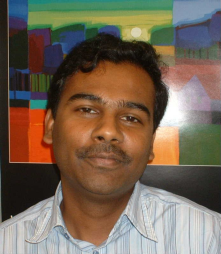Rapid single flux quantum logic in high temperature superconductor technology
Promotion Date: 13 October 2006
| Superconducting electronics is based on Josephson junctions. A Josephson junction consists of two superconducting electrodes separated by a very thin insulating layer. A fast switching time of Josephson junctions of the order of few picoseconds (pico multiplies a metric unit by 1/1012) and low power dissipation make them suitable for high speed processing in wire-less technology, military applications, high speed computing and digital signal processing circuits. Josephson junctions are the active devices used in Superconducting logic circuit. Every switching of a Josephson junction is associated with a very short voltage pulse. We call these pulses Single flux Quantum (SFQ) pulses. |
What was your thesis about?
Superconducting electronics is based on Josephson junctions. A Josephson junction consists of two superconducting electrodes separated by a very thin insulating layer. A fast switching time of Josephson junctions of the order of few picoseconds (pico multiplies a metric unit by 1/1012) and low power dissipation make them suitable for high speed processing in wire-less technology, military applications, high speed computing and digital signal processing circuits.
Josephson junctions are the active devices used in Superconducting logic circuit. Every switching of a Josephson junction is associated with a very short voltage pulse. We call these pulses Single flux Quantum (SFQ) pulses. SFO pulses can be generated, reproduced, transmitted and processed by Josephson logic circuits. A high switching speed, low power and quantum accuracy make Josephson logic circuits suitable for fast Analog to Digital Converters (ADC). I was involved in designing an over-sampling delta-sigma converter.
One of the main problems in Josephson logic is to transfer information in the form of SFQ pulses to room temperature electronics. SFQ pulses must be amplified to be detected by a semiconducting amplifier. We investigated a pulse stretcher (converting an SFQ pulse into an extended voltage pulse) as an interfacing circuit between two different logic circuits.
Josephson junctions are fabricated in high temperature superconductor (HTS) technology. High quality junctions require a fully epitaxial multilayer technology and cleaned interfaces. Realization of circuits needs reproducible junctions with a low spread in parameters.
Did you succeed?
Yes. We designed a second order superconducting delta-sigma modulator and its functionality is verified by simulations. A pulse stretcher circuit has been simulated and fabricated in HTS junction technology and its correct operation is successfully measured by experiments.
Are superconductors used in daily life?
They still need extremely low temperatures in order to function, because what we call ‘high temperature’ is still way below zero. But they are used in MRI equipment, voltage standard, non destructive testing. Not in consumer electronics, but have a great future in radar and wireless technology.
Did you work in the cleanroom yourself?
Yes, I liked working on my own chip.
You are from India?
Yes, from the south. My brother did his PhD here in Twente and when I completed my studies I applied in this area, in Germany and the Netherlands. I was accepted here.
What did you like best about your research?
I liked the scientific environment, we had a lot of group discussions. You can easily approach anybody, you can get help quickly and all in a very pleasant way. And this was a European project, so I have travelled a lot. Every meeting was held in a different place. I have been to Spain, Italy, Corsica and had many international collaborations.
Did you encounter any problems?
Mainly the language and bureaucratic things, like the extension of my residence permit.
What are your plans for the future?
I would like to continue in this field, so I am looking for a job in Sweden or in Britain.
For the summary of the thesis, click here.

